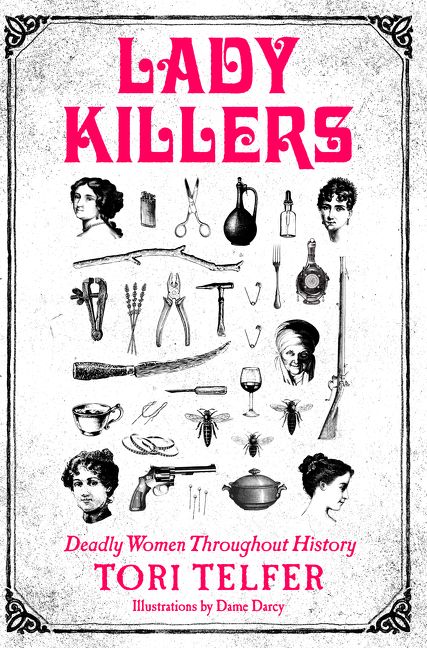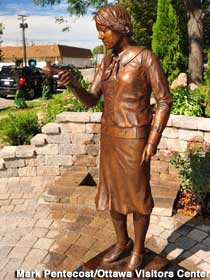My last book for March and book 99 on my book list is Lady Killers: Deadly Women Throughout History by Tori Tefler.
Tefler writes about female serial killers throughout history including: Erzebet Bathory: The Blood Countess Lizzie Halliday: The Worst Woman On Earth, Tillie Klimek: High Priestess of the Bluebeard Clique, Raya and Sakina: Vipers and more.
Tefler avoids the sensationalism that is often associated with serial killers, but especially with female serial killers. Serial killers are anomalies and female ones even more so. In order to explain their monstrosity, perversion, inhuman, and un-womanly behavior, female serial killers' crimes are often attributed to over-sexualization, abuse, mental deficiencies, or hysteria. Tefler presents these women as women and human, however flawed they may have been. Tefler avoids exoticising and objectifying these female serial killers and instead tries to understand the motivations behind their crimes.
Saturday, March 31, 2018
Thursday, March 29, 2018
The Butterfly Mosque
The Butterfly Mosque by G. Willow Wilson
Willow was raised as an atheist in Colorado, but was attracted to Islam and Arabic in college. Post 9/11, Willow went to Cairo, Egypt for a semester to teach English. She stayed and immersed herself fully in Cairene culture. Willow fell in love with Omar and the two began a relationship and later married. The Butterfly Mosque is Willow's memoir of her physical and spiritual journey in Cairo. I was particularly struck by her conversion to Islam; a choice she made before meeting Omar and one that was expressed personally and internally more so than externally.
Here are a few quotes I liked:
Prior to announcing their intended married to her mother-in-law: "I don't like just showing up like this. 'Hi, I'm your white American in-the-closet-convert future daughter-in-law. I've brought you some flowers and a catastrophe.'" (50)
On her conversion: "Looking back, the way I chose to "come out" taught me something vital: anything undertaken with honest intentions can be justly defended. I never by word or action claimed to possess a higher or a universal truth, only a very personal one; i think this was one of the main reasons I was able to slip quietly into "ordinary" Islam, without the fanfare that accompanies conversion. I never tried to become a mascot; I was just a person, with the usual quirks and faults, who was now Muslim" (107).
On engaging with native and other cultures: "The reason I had stayed in Egypt and invested myself in it so thoroughly was simple: this was the place I found myself in and the people I found myself among, and I wanted to do right by them. I had gone to Egypt to see what Islam was like as a practice and to find out whether the Arab world resembled the one portrayed in the media; I had stayed not to see, but to participate. I had discovered that both Islam and the Arab world were far from ideal--that the religion I loved was becoming steadily warped and was the source of many excuses for violence and ignorance and misanthropy. Yet I was not disappointed. This was what was so impossible to explain to the satisfaction of the people back home: I was not disappointed" (230).
Willow was raised as an atheist in Colorado, but was attracted to Islam and Arabic in college. Post 9/11, Willow went to Cairo, Egypt for a semester to teach English. She stayed and immersed herself fully in Cairene culture. Willow fell in love with Omar and the two began a relationship and later married. The Butterfly Mosque is Willow's memoir of her physical and spiritual journey in Cairo. I was particularly struck by her conversion to Islam; a choice she made before meeting Omar and one that was expressed personally and internally more so than externally.
Here are a few quotes I liked:
Prior to announcing their intended married to her mother-in-law: "I don't like just showing up like this. 'Hi, I'm your white American in-the-closet-convert future daughter-in-law. I've brought you some flowers and a catastrophe.'" (50)
On her conversion: "Looking back, the way I chose to "come out" taught me something vital: anything undertaken with honest intentions can be justly defended. I never by word or action claimed to possess a higher or a universal truth, only a very personal one; i think this was one of the main reasons I was able to slip quietly into "ordinary" Islam, without the fanfare that accompanies conversion. I never tried to become a mascot; I was just a person, with the usual quirks and faults, who was now Muslim" (107).
On engaging with native and other cultures: "The reason I had stayed in Egypt and invested myself in it so thoroughly was simple: this was the place I found myself in and the people I found myself among, and I wanted to do right by them. I had gone to Egypt to see what Islam was like as a practice and to find out whether the Arab world resembled the one portrayed in the media; I had stayed not to see, but to participate. I had discovered that both Islam and the Arab world were far from ideal--that the religion I loved was becoming steadily warped and was the source of many excuses for violence and ignorance and misanthropy. Yet I was not disappointed. This was what was so impossible to explain to the satisfaction of the people back home: I was not disappointed" (230).
Monday, March 26, 2018
The Woman in the Photograph
The Woman in the Photograph by Dana Gynther
In 1929, Lee Miller heads to France. After seeing a photograph that Man Ray took of Kiki de Montparnasse, Lee decides that she MUST work for Man Ray and study his technique. Lee tracks him down and the two quickly begin a personal and professional relationship. Man declares that Lee is his muse, but as she works for him and alongside him, Lee's talents as a photographer develop. Lee seeks out her own jobs as a photographer, for Vogue, at the Sorbonne, and even stars in a Surrealist movie. Lee's independence angers the possessive Man Ray and drives a wedge between them. Lee is no longer content to simply be a muse, her artistic vision is paramount to her.
As far as the identity of the woman in the photograph, I think there are a few possibilities. I'm not referring to a specific photograph mentioned in the novel; in fact any of them will work. The woman could refer to Kiki, whose photograph by Man Ray first caught Lee's interest in his work. The woman could be Lee herself in the portraits of her taken by Man Ray. Or, the woman is the anonymous woman or muse captured on film, often cropped, edited, or "photoshopped" to bits and no longer recognizable as any specific woman, but merely an assemblage of body parts.
Based on actual events and people, I enjoyed learning about two photographers I knew nothing about.
In 1929, Lee Miller heads to France. After seeing a photograph that Man Ray took of Kiki de Montparnasse, Lee decides that she MUST work for Man Ray and study his technique. Lee tracks him down and the two quickly begin a personal and professional relationship. Man declares that Lee is his muse, but as she works for him and alongside him, Lee's talents as a photographer develop. Lee seeks out her own jobs as a photographer, for Vogue, at the Sorbonne, and even stars in a Surrealist movie. Lee's independence angers the possessive Man Ray and drives a wedge between them. Lee is no longer content to simply be a muse, her artistic vision is paramount to her.
As far as the identity of the woman in the photograph, I think there are a few possibilities. I'm not referring to a specific photograph mentioned in the novel; in fact any of them will work. The woman could refer to Kiki, whose photograph by Man Ray first caught Lee's interest in his work. The woman could be Lee herself in the portraits of her taken by Man Ray. Or, the woman is the anonymous woman or muse captured on film, often cropped, edited, or "photoshopped" to bits and no longer recognizable as any specific woman, but merely an assemblage of body parts.
Based on actual events and people, I enjoyed learning about two photographers I knew nothing about.
Thursday, March 22, 2018
The Radium Girls
The Radium Girls: The Dark Story of America's Shining Women by Kate Moon
Lip...dip...paint...
Following the Curies' discovery of radium in 1898, radium was everywhere in the early 1900s. Radium's harmful effects were hidden from the public and radium powder was put in tonic water, body lotion, everything.
Radium's glowing property made it essential to the war effort. Women were hired to paint watch dials with radium powder that would glow in the dark. The United States' entry into WWI in 1917 skyrocketed the need for women dial painters.
The Radium Girls tells the story of dial painters in New Jersey at the Radium Luminous Materials Corporation, later the United States Radium Corporation, and in Ottawa, Illinois at the Radium Dial Company.
So harmless was radium powder declared to be that the dial painters fairly bathed in it. They sometimes used extra powder like makeup, and the powder inevitably settled into their clothes and hair. "When I went home and washed my hands in a dark bathroom, they would appear luminous and ghostly. My clothes, hanging in a dark closet, gave off a phosphorescent glare. When I walked along the street, I was aglow from the radium powder" (44). The dial painters were laughingly called "ghost girls".
Unfortunately, the harmful radium powder entered their bodies. The technique of lip...dip...paint meant that the girls ingested small quantities of radium each day. The radium powder settled in their bodies and remained their for years, haunting them.
As we know today, and indeed scientists knew it then, exposure to radium is harmful. The "ghost girls" became the walking dead. Many dial painters became ill and died from their work...losing teeth, jawbones, developing cancers or sarcomas...
Many of the women believed that their employers were responsible for their ill-health. Together they filed several lawsuits. The mistreatment of the dial workers ultimately led to the creation of OSHA.
"United they triumphed. Through their friendship, through their refusal to give up and through their sheer spirit, the radium girls left us all an extraordinary legacy. They did not die in vain. They made every second count" (396).
Newspaper coverage of Catherine Donahue's trial
Memorial Statue in Ottawa, Illinois
Lip...dip...paint...
Following the Curies' discovery of radium in 1898, radium was everywhere in the early 1900s. Radium's harmful effects were hidden from the public and radium powder was put in tonic water, body lotion, everything.
Radium's glowing property made it essential to the war effort. Women were hired to paint watch dials with radium powder that would glow in the dark. The United States' entry into WWI in 1917 skyrocketed the need for women dial painters.
The Radium Girls tells the story of dial painters in New Jersey at the Radium Luminous Materials Corporation, later the United States Radium Corporation, and in Ottawa, Illinois at the Radium Dial Company.
So harmless was radium powder declared to be that the dial painters fairly bathed in it. They sometimes used extra powder like makeup, and the powder inevitably settled into their clothes and hair. "When I went home and washed my hands in a dark bathroom, they would appear luminous and ghostly. My clothes, hanging in a dark closet, gave off a phosphorescent glare. When I walked along the street, I was aglow from the radium powder" (44). The dial painters were laughingly called "ghost girls".
Unfortunately, the harmful radium powder entered their bodies. The technique of lip...dip...paint meant that the girls ingested small quantities of radium each day. The radium powder settled in their bodies and remained their for years, haunting them.
As we know today, and indeed scientists knew it then, exposure to radium is harmful. The "ghost girls" became the walking dead. Many dial painters became ill and died from their work...losing teeth, jawbones, developing cancers or sarcomas...
Many of the women believed that their employers were responsible for their ill-health. Together they filed several lawsuits. The mistreatment of the dial workers ultimately led to the creation of OSHA.
"United they triumphed. Through their friendship, through their refusal to give up and through their sheer spirit, the radium girls left us all an extraordinary legacy. They did not die in vain. They made every second count" (396).
Newspaper coverage of Catherine Donahue's trial
Memorial Statue in Ottawa, Illinois
Thursday, March 15, 2018
Winter Solstice
#95
Winter Solstice by Rosamunde Pilcher
This pleasant story about the families we have and those that we make, takes place around Christmas.
Elfrida, aged 62, is a retired actress. After her lover dies, she moves from London to a small English village (the type of village featured on "Escape to the Country") and befriends the Blundells--Oscar, Gloria, and their daughter Francesca. Following a tragedy, Elfrida and Oscar move to Scotland, to Oscar's family home. Oscar and Elfrida seem to attract other strays, people down and out on their luck or simply at a crossroads in life.
I enjoyed this cosy story and the patchwork of friends and family Pilcher created. This was the first novel by Pilcher that I have read and I think I'll read some more.
Winter Solstice by Rosamunde Pilcher
This pleasant story about the families we have and those that we make, takes place around Christmas.
Elfrida, aged 62, is a retired actress. After her lover dies, she moves from London to a small English village (the type of village featured on "Escape to the Country") and befriends the Blundells--Oscar, Gloria, and their daughter Francesca. Following a tragedy, Elfrida and Oscar move to Scotland, to Oscar's family home. Oscar and Elfrida seem to attract other strays, people down and out on their luck or simply at a crossroads in life.
I enjoyed this cosy story and the patchwork of friends and family Pilcher created. This was the first novel by Pilcher that I have read and I think I'll read some more.
Subscribe to:
Comments (Atom)






